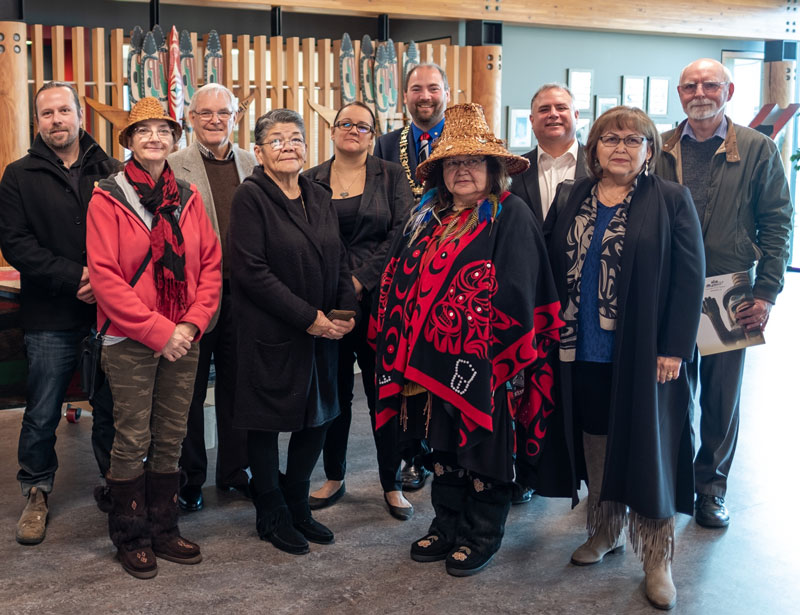A historic milestone in reconciliation and intergovernmental relations has taken place in the Comox Valley. A First Nation, a municipality and an environmental non-profit have signed a Memorandum of Understanding (MOU) to collaboratively purchase, restore and manage a key property in the heart of their community. The three signatories, the K’ómoks First Nation, the City of Courtenay and Comox Valley Project Watershed Society are working together with Interfor Corporation, the current owners of the property, to acquire and then restore a former sawmill site to natural habitat. The site has been renamed Kus-kus-sum.
“K’omoks First Nation believes in partnerships, particularly when partnerships involve like-minded groups that share similar vision. It is in this spirit that we are happy to sign this collaborative agreement with the City of Courtenay and Project Watershed on behalf of our membership for the management and restoration of Kus-kus-sum,” stated Chief Nicole Rempel, K’ómoks First Nation. “Restoring this cultural and historically significant site is a vision KFN shares with Project Watershed and the City of Courtenay. KFN’s interest in the site is largely based on its strong cultural significance. At the time of contact and settlement, there were tree burials on the Dyke road side of the river just downstream of Fields Sawmill. While there is some documentation of these burials in various writings and oral history, they are not extensively documented, and may have been extensive along the lower part of the river. Being stewards of the lands and waters, it is inherently our duty to restore and assist in the rehabilitation of the natural habitat of the salmon and various marine and wildlife in this area. It is our hope for the future that our skilled Guardian Watchmen participate in the restoration and maintenance of the site for our future generations.”
Participation in this project is without prejudice to any specific claim the K’omoks First Nation may file in relation to this site.
Since 2006, Kus-kus-sum has remained as 8.3 acres of vacant cement along a critical salmon migration corridor in the heart of the Comox Valley. As part of the Kómoks Estuary, the restored area at Kus-kus-sum will provide fish and wildlife habitat, help mitigate climate change, buffer against sea level rise, attenuate localized flooding, become a culturally significant landmark and provide educational and recreational opportunities. The restored habitat will be particularly beneficial for young salmon, which require a place to escape high river flows, predation by seals, and holding areas to allow for forage, growth, and acclimatization to increasing salinities before their marine migration.
Although non-binding, this initial agreement formalizes the partnership between the three parties in relation to Kus-kus-sum and outlines the issues that need to be addressed in further documents. It sets Oct 20th, 2019 as the date for entering a binding agreement that will detail the nuances of purchasing, restoring and managing the property collaboratively.
“Working collaboratively with Project Watershed and K’omoks First Nation has been an essential component of this project, and as we move forward through the formal agreement process we look forward to building on this strong relationship with our project partners. The restoration of Kus-kus-sum will have tremendous cultural, environmental, social, and economic benefits, and the community has shown a high level of enthusiasm over the future vision for this site.” reports David Allen, City of Courtenay Chief Administrative Officer.
The MOU states that the City of Courtenay and K’ómoks First Nation will be co-owners of the land once it has been purchased and identifies Project Watershed as the lead in carrying out the restoration and fundraising campaign. The cost of purchasing and restoring the site has been estimated at $6.5 million.
A fundraising campaign was initiated by Project Watershed in September 2017.
“This project has been met with widespread community support” reports Paul Horgen, Chair of Project Watershed. “Our community fundraising target was set at $500,000 and we are already more than halfway there.”
To date, the organization has raised $277,000 from the community and almost 1 million in total from foundations and government agencies.
While the property may be on the site of an old K’ómoks First Nation Village, the K’ómoks First Nation’s participation in the project and the MOU is without prejudice to any specific claim K’ómoks may have on file and will not affect K’ómok’s asserted Aboriginal title or other Aboriginal rights.
The next steps the three signatories are faced with are to draft and finalize the binding agreement before Oct 20th, 2019 and raise the funds necessary to purchase the property. If the purchase price is not met then the property could go back on the market. For more information on the project visit www.kuskussum.ca.

A Historic Moment in Reconciliation – Back Left to Right – Tim Ennis, Kus-kus-sum Senior Project Manager- Project Watershed; Don Castleden, Estuary Working Group Chair – Project Watershed; Chief Nicole Remple, K’ómoks First Nation; Mayor Bob Wells, City of Courtenay; MP Gord Johns, Courtenay-Alberni
Front Left to Right – K’ómoks First Nation Elders; Margaret Mitchell, Bunny Price, Donna Mitchell and Fernanda Pare (Photo Credit: Danielle Dufour)